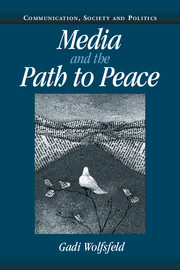Crossref Citations
This Book has been
cited by the following publications. This list is generated based on data provided by Crossref.
Jarstad, Anna K.
and
Sisk, Timothy D.
2001.
From War to Democracy.
Bar‐Tal, Daniel
2004.
The necessity of observing real life situations: Palestinian‐Israeli violence as a laboratory for learning about social behaviour.
European Journal of Social Psychology,
Vol. 34,
Issue. 6,
p.
677.
Ross, Susan Dente
and
Bantimaroudis, Philemon
2006.
Frame Shifts and Catastrophic Events: The Attacks of September 11, 2001, and New York Times's Portrayals of Arafat and Sharon.
Mass Communication and Society,
Vol. 9,
Issue. 1,
p.
85.
Wolfsfeld, Gadi
and
Sheafer, Tamir
2006.
Competing Actors and the Construction of Political News: The Contest Over Waves in Israel.
Political Communication,
Vol. 23,
Issue. 3,
p.
333.
Maoz, Ifat
2006.
The Effect of News Coverage Concerning the Opponents' Reaction to a Concession on Its Evaluation in the Israeli-Palestinian Conflict.
Harvard International Journal of Press/Politics,
Vol. 11,
Issue. 4,
p.
70.
Maoz, Ifat
and
Eidelson, Roy J.
2007.
Psychological Bases of Extreme Policy Preferences.
American Behavioral Scientist,
Vol. 50,
Issue. 11,
p.
1476.
Rolston, Bill
2007.
Facing reality: The media, the past and conflict transformation in Northern Ireland.
Crime, Media, Culture: An International Journal,
Vol. 3,
Issue. 3,
p.
345.
Shehata, Adam
2007.
Facing the Muhammad Cartoons: Official Dominance and Event-Driven News in Swedish and American Elite Press.
Harvard International Journal of Press/Politics,
Vol. 12,
Issue. 4,
p.
131.
Hanitzsch, Thomas
2007.
Kriegskorrespondenten.
p.
39.
Rahat, Gideon
and
Sheafer, Tamir
2007.
The Personalization(s) of Politics: Israel, 1949–2003.
Political Communication,
Vol. 24,
Issue. 1,
p.
65.
Frosh, Paul
and
Wolfsfeld, Gadi
2007.
ImagiNation: news discourse, nationhood and civil society.
Media, Culture & Society,
Vol. 29,
Issue. 1,
p.
105.
Seib, Philip
2007.
New Media and the New Middle East.
p.
1.
Bar-Tal, Daniel
and
Sharvit, Keren
2007.
The Israeli-Palestinian Conflict.
p.
169.
Neiger, Motti
2007.
Media oracles.
Journalism,
Vol. 8,
Issue. 3,
p.
309.
OJWANG', BENSON ODUOR
2008.
How language aggravates conflict.
Journal of International Communication,
Vol. 14,
Issue. 2,
p.
143.
Powers, Shawn
2008.
Examining the Danish cartoon affair: mediatized cross-cultural tensions?.
Media, War & Conflict,
Vol. 1,
Issue. 3,
p.
339.
Maoz, Ifat
2008.
'They saw a terrorist'--Responses of Jewish-Israeli viewers to an interview with a Palestinian terrorist..
Peace and Conflict: Journal of Peace Psychology,
Vol. 14,
Issue. 3,
p.
275.
Bratic, Vladimir
2008.
Examining Peace-Oriented Media in Areas of Violent Conflict.
International Communication Gazette,
Vol. 70,
Issue. 6,
p.
487.
Shenhav, Shaul R.
and
Sheafer, Tamir
2008.
From Inter-Party Debate to Inter-Personal Polemic.
Party Politics,
Vol. 14,
Issue. 6,
p.
706.
Strömbäck, Jesper
Shehata, Adam
and
Dimitrova, Daniela V.
2008.
Framing the Mohammad cartoons issue.
Global Media and Communication,
Vol. 4,
Issue. 2,
p.
117.



